More evidence suggests IOL optic material and design can affect PCO
A new study reinforces the notion that square-edged acrylic IOLs prevent PCO.
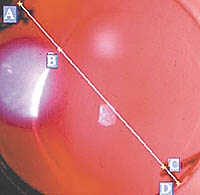 ---Capsulorrhexis size is calculated by pixel coordinates at X and Y values. A=223, 71; B=286, 141; C=467, 342; and D=484, 372.
---Capsulorrhexis size is calculated by pixel coordinates at X and Y values. A=223, 71; B=286, 141; C=467, 342; and D=484, 372.
VIENNA — A clinical evaluation of five IOLs concluded that lens material and design play important roles in centration and opacification after implantation. The study, by Richard B. Packard, MD, FRCS, of the Prince Charles Eye Unit in Windsor, found that plate haptic silicone IOLs are less stable within the capsule than those with PMMA haptics, and that the Alcon (Fort Worth, U.S.A.) AcrySof MA60 had the best overall anterior and posterior capsular performance of any of the IOLs evaluated. The Iogel 2000 hydrogel IOL, manufactured by Gelflex Laboratories of Western Australia, also fared well in tests.
Less change
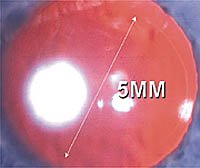 STAAR AA4203 at day 1. | 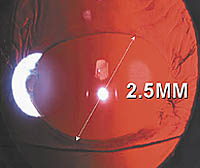 STAAR AA4203 at 6 months. |
“The AcrySof lens appears to show less change in the anterior capsule than the silicone, as does the Iogel lens, “Dr. Packard told attendees of the European Society of Cataract and Refractive Surgeons meeting. “Silicone [plate lenses] appear to decenter more frequently — certainly more than the three-piece silicone lenses, and there appears to be at least some evidence that the edge of the AcrySof lens is very important in the prevention of opacification.”
The square edge of the AcrySof lens is one attribute that may induce a barrier effect that blocks the migration of epithelial cells across its surface and, therefore, prevents posterior capsule opacification (PCO).
Five lenses, four types
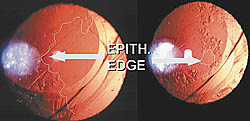 ---The epithelial edge as shown in an eye implanted with the STAAR AA4203 at 6 months (left) and at 24 months (right).
---The epithelial edge as shown in an eye implanted with the STAAR AA4203 at 6 months (left) and at 24 months (right).
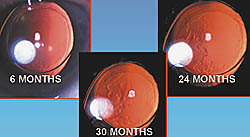 ---Iogel 2000SM at 6 months, 24 months and 30 months.
---Iogel 2000SM at 6 months, 24 months and 30 months.
Fifty patients, all of whom were treated using the same phacoemulsification technique by one surgeon, were implanted with one of five lenses. The lenses used represent four material types: acrylic, hydrogel, PMMA and silicone. (For an overview of study IOLs, material type and findings, please see the chart on page 6.) Patients were monitored for 30 months following the date of their surgery.
Patients were photographed 1 day, 1 month, 6 months, 12 months, 18 months, 24 months and 30 months following surgery.
Digitized photographs
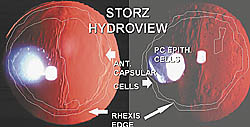 ---Storz Hydroview at 6 months (left) and at 24 months (right).
---Storz Hydroview at 6 months (left) and at 24 months (right).
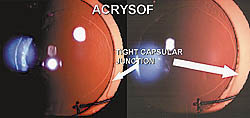 ---Alcon MA60 AcrySof at 1 month (left) and at 18 months (right).
---Alcon MA60 AcrySof at 1 month (left) and at 18 months (right).
“We looked at capsulorrhexis size using photography of the red reflex by a standard system,” Dr. Packard said. Digitized photographs showing pixel points of the edge of the optic and the edge of the capsulorrhexis were recorded.
“If you have these points available, knowing the size of the optic in each case, you can work out with a great deal of accuracy how the capsular size has changed,” Dr. Packard said.
Dr. Packard first looked at the contraction of the capsulorrhexis, paying close attention to those greater than 20% of the total size. Examination revealed that the contractions in excess of 20% were only identified in patients who received silicone lenses, in this case the STAAR (Monrovia, U.S.A.) plate haptic and the Allergan (Irvine, U.S.A.) SI40. Capsular contraction also seemed only to affect the silicone lens patients.
“If you look at capsular phimosis, which I defined as a contraction of the anterior capsular opening of greater than 50%, it only affects the silicone lenses, but it is much greater in the plate haptic lens than it is in the three-piece Allergan lens,” he said.
Decentration of greater than 2 mm was observed only in patients with the STAAR plate haptic IOL.
Clarity in the posterior capsule was best in the Alcon AcrySof MA60, Dr. Packard reported.
“There’s almost no change between the 18-month and the 24-month stage,” he said. “However, in the other lens types, these gradually leech away and we see as we go into the minimal and then moderate and then finally complete epithelialization that there is a significant change over time.”
Thin cell layer
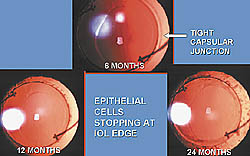 ---Epithelial cells stopping at IOL edge of the AcrySof MA60.
---Epithelial cells stopping at IOL edge of the AcrySof MA60.
The Hydroview (Bausch & Lomb Surgical, Claremont, U.S.A.) lenses tested exhibited moderate lens epithelialization 18 months after surgery. Complete epithelialization was apparent at 24 months in more than 70% of patients.
“This is not to say that these patients have necessarily lost vision, because there can be a very thin layer of cells that covers the whole posterior capsule,” Dr. Packard said. “But it’s interesting that none of the patients at this stage with the AcrySof lens are showing this change.”
| Lens material and design vs. PCO and decentration A summary of the Prince Charles Eye Unit Findings | ||||
| Lens Alcon AcrySof MA60 | Material Acrylic | Findings Little PCO | ||
| Allergan SI40 | Silicone IOL, | Contractions >20% | ||
| Iogel 2000 | Hydrogel | Moderate PCO at 18, 24, and 30 months | ||
| STAAR AA4203 | Silicone | Contractions >20% | ||
| Bausch & Lomb Hydroview Source: Richard Packard, MD, FRCS | Hydrogel | Complete lens epithelialization in <70% of patients at 24 months | ||
For Your Information:
- Richard B. Packard, MD, FRCS, can be reached at Princess Christians Hospital, 12 Clarence Road, Windsor SL4 5AG England; +(44) 1753-829204; fax: +(44) 1753-831185. Dr. Packard has no direct financial interest in any of the products mentioned in this article. He is a paid consultant for Alcon.
- Alcon can be reached at 6201 South Freeway, Fort Worth, TX 76134 U.S.A.; +(1) 817-551-6828; fax: +(1) 817-568-7116.
- Allergan Inc. can be reached at 2525 Dupont Drive, Irvine, CA 92612 U.S.A.; +(1) 714-246-2201; fax: +(1) 714-246-4297.
- Bausch & Lomb Surgical can be reached at 555 W. Arrow Highway, Claremont, CA 91711 U.S.A.; +(44) 1-344-30-03-30; fax: +(44) 1-344-45-45-58.
- STAAR Surgical Co. can be reached at 1911 Walker Ave., Monrovia, CA 91016 U.S.A.; +(1) 818-303-7902; fax: +(1) 818-358-9187.
